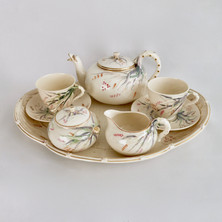Parian: for the gods
- willa
- Aug 17, 2019
- 2 min read
You will have seen sculpted putti, or cherubs, like these before, and here is the story of how these were made. They were made of parian porcelain, which was the invention of Thomas Battam, the Art Director of Copeland (formerly Spode). He wanted to make figures with more definition, like the German and French factories were able to make.
As soon as he had presented his new invention to the world in 1844, Minton copied it. They became the more famous maker of parian figures; they liked to pretend they came up with it and gave it its name.
Parian porcelain is named after the Greek island of Paros, where the Greeks got their marble from for the famous figures for their temples - you could rightly say that parian porcelain is for the gods!
It can be shaped in a very fine way, and it doesn't get dirty like biscuit porcelain, so it doesn't need glazing. Glaze obscures much of the detail of figures, so this parian body enabled the artist to give their figure much finer detail. You can see this on these fabulous and rare potpourri vases.
These two lidded vases were made by Copeland in 1891 and they have wonderful parian porcelain putti, or cherubs, on the base. They busy themselves with squeezing grapes.
In the 19th Century Victorian home, fresh air was sometimes in short supply. So people had potpourri vases in their homes, filled with scented materials. Of course that was a great excuse for porcelain makers to make outrageous pieces that would be fantastic for home decoration.
You can find these potpourri vases and many more treasures in my shop. Have a wonderful weekend!
This week's new treasures:
#gentlerattleofchina #antiqueporcelain #englishantiques #highteaparty #teacupcollector #19thcentury #vintageteaparty #rattlethecups #homedecor #decorativeitem #interiordesign #interiordesignideas #decorativeitems #englishporcelain #handpaintedfruits #charger #potpourri #parianporcelain #copeland #vase #antiquevase #decorativevase #spode #copelandspode #cherubs #putti #parian





































































Kommentare